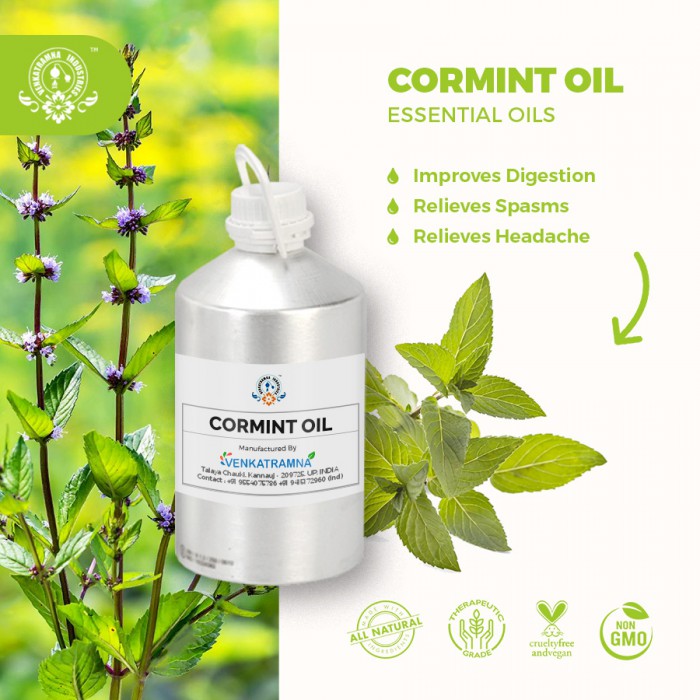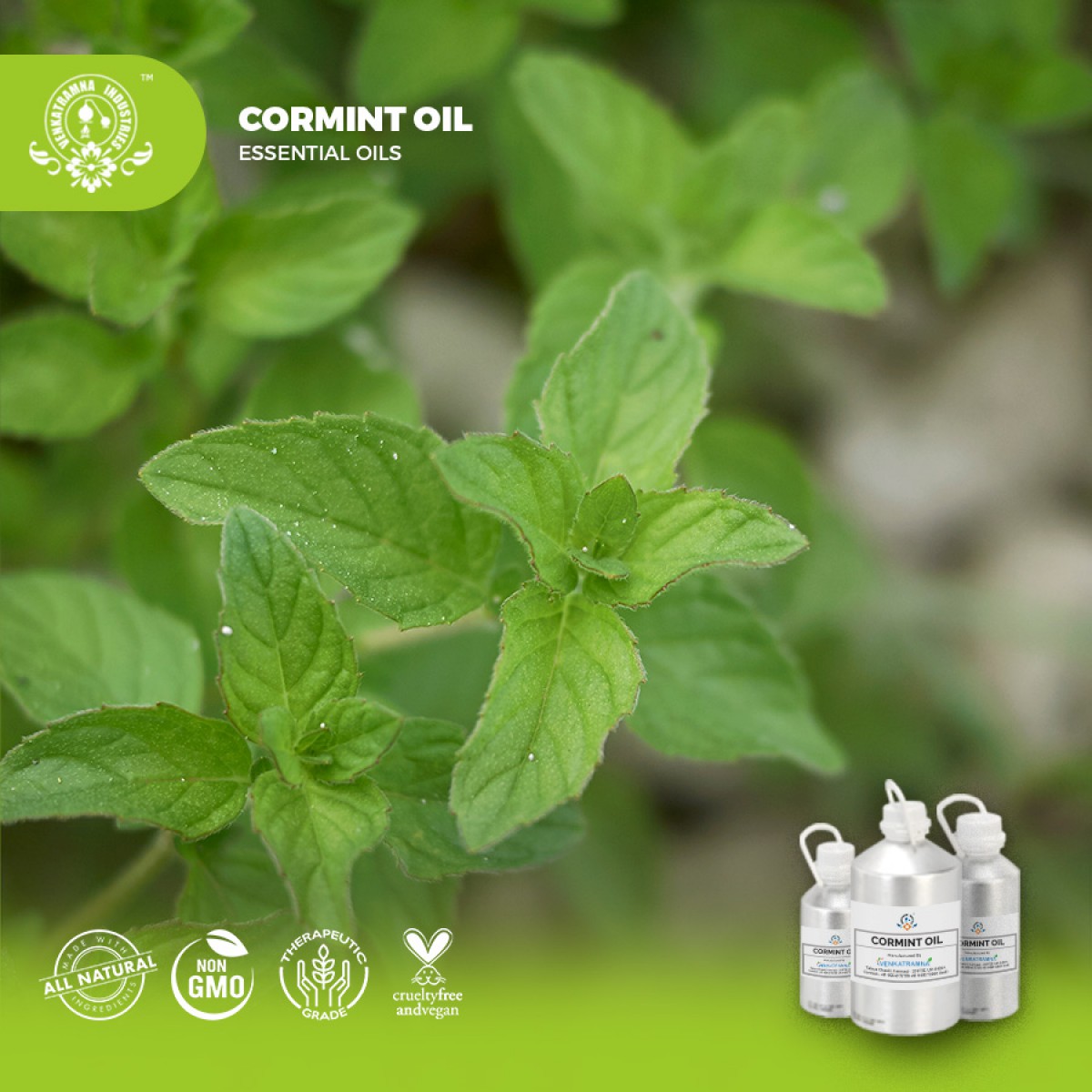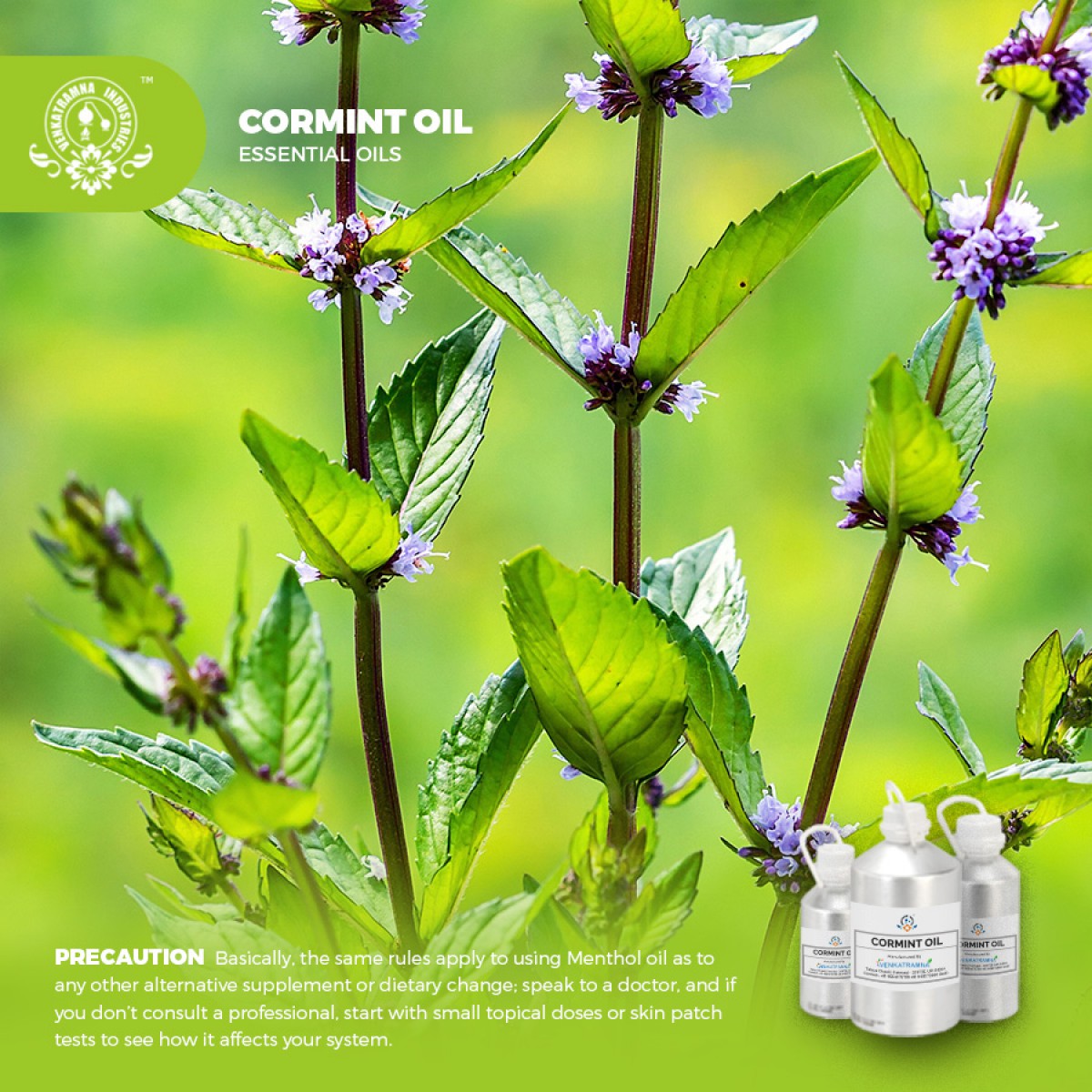Botanical Name: Mentha arvensis Common name: Corn mint, field mint, wild mint, pudina Read More
|
Botanical Name: |
Mentha arvensis |
|
Common name: |
Corn mint, field mint, wild mint, pudina |
|
Plant family: |
Lamiaceae |
|
Genus: |
Mentha |
|
Appearance/Color: |
Slight yellow to colorless clear liquid. |
|
Odor: |
fresh, soft, bitter-sweet minty aroma |
|
Blends With: |
Tea Tree, Cypress, Grapefruit, Lavender, Juniperberry,
Marjoram, Rosemary, Basil and Lemon. |
|
Origin: |
India |
Mentha arvensis is a perennial
plant belonging to the Mentha genus. This mint plant is found in various parts
of Europe, Asia and North America. Its common names include Field Mint, Wild
Mint or Corn Mint; however, it is better known by its scientific name Mentha
arvensis. The leaves of this herbal plant have a fresh minty flavor and are
used for culinary and medicinal purposes. The essential oil extracted from the
leaves also has many uses.
These herbal plants have been used by humans for approximately 2000 years. It is believed that these plants were first cultivated in Europe during ancient times. However, Japan started cultivating these mint plants for commercial purposes in the late nineteenth century. Countries like China and Japan used them for various medicinal purposes. Later they were introduced to India where they are still known as Pudina.
DISCLAIMER
The complete range of conditions
or methods of use are beyond our control therefore we do not assume any
responsibility and expressly disclaim any liability for any use of this
product. Information contained herein is believed to be true and accurate however,
all statements or suggestions are made without warranty, expressed or implied,
regarding accuracy of the information, the hazards connected with the use of
the material or the results to be obtained from the use thereof. Compliance
with all applicable federal, state, and local laws and local regulations
remains the responsibility of the user.
The FDA has not evaluated the
statements on this website. No claims are made by Venkatramna Industries as to
the medicinal value of any products from vriaroma.com or by us. The information
presented here is for educating our customers about the traditional uses of
essential oils and is not intended to diagnose, treat, cure, or prevent any
disease. You are responsible for understanding the safe application of these products.
If you have any questions, please call or email us for further information.
As per NAHA guidelines, New Directions Aromatics
(NDA) does not recommend the ingestion of essential oils. It is imperative to
consult a medical practitioner before using Essential Oils for therapeutic
purposes. Pregnant and nursing women and those taking prescription drugs are
especially advised not to use this product without the medical advice of a
physician. The oil should always be stored in an area that is inaccessible to
children, especially those under the age of 7.
Mentha arvensis Linn. family
Lamiaceae, it is used as a food seasoner, household remedy, and industrial
purposes it is traditionally used in hypertension and in patients with ischemic
heart disease. Juice of leaves is given in diarrhea and dysentery. The leaves
medicinally used for stomach problems and allergy. It is also used for the
treatment of liver and spleen disease, asthma and jaundice. The infusion of
these leaves is used in indigestion, rheumatic pains, arthritis, and as remedy
for inflamed joints. Menthol derived from its essential oil is used in
pharmaceutical, perfumery, and food industries. Menthol is antiseptic,
carminative, refrigerant, stimulant and diuretic in properties and is used
against skin infections. It has been reported to possess diverse medicinal
properties, and hence there is a need to explore its medicinal properties to
support the traditional claim.
Cormint Essential Oil in
Pharma
Oil is extracted from the leaves
of the Field Mint or Pudina plants using the steam distillation process. The
pale yellow essential oil has a bitter-sweet minty aroma. The principal
constituents of this oil include Camphene, Menthol, Menthone, Neomenthol,
l-menthol, Pinene and Limonene. This oil is used for various medicinal purposes;
however, it is not use in homeopathic treatments. The Mint leaves can work as
blood cleanser with their antibacterial and antiseptic properties. It can
alleviate mouth ulcers, toothache and swollen gum. Fresh leaves can cure
headache and dizziness. Mint leaves can relief arthritis and joint pains. The
leaf infusion helps in curing health disorders like dysmenorrheal, stomachache
and diuresis. These plants have antispasmodic and anesthetic properties. Having
expectorant properties makes it beneficial for cough, cold, sore throat and
fever. The oil extraction of these plants cures various skin problems like
acne, ulcer and boils. The oil is beneficial for the nervous system.
Essence of Cormint Essential
Oil
There are diverse edible and
medicinal uses of the leaves and essential oil of these plants. The mint
flavored leaves are used as herb in various cuisines. Sometimes raw leaves are
added to salads and other preparations to add flavor to the food. Fresh or
dried leaves are used to make herbal tea. Fresh leaves are also used to make
chutneys. The oil extracted from these plants is used as a flavoring agent for
beverages and sweets.
Mentha arvensis oil is used in
soaps, perfumes and other cosmetic products. It is also used as a fragrance
element in detergents. This oil is used in aromatherapy. The leaves as well as
the oil of these plants are used in toothpastes and mouthwashes. These leaves
are also used as insect repellant.
COMMON USAGE
·
Improves digestion
·
Dental care
·
Nail care
·
Relieves headache
·
Reduces spasms
·
Treats urinary tract infection
·
Treats respiratory problems
·
Reduces pain
·
Boosts immunity
·
Improves blood circulation
·
Hair care
·
Skin care
Ingredients:
|
S.No |
Key Constituents |
Strength (%) |
|
1 |
Menthol |
28.88-34.7 |
|
2 |
Menthone |
16.3-31.1 |
|
3 |
isomenthone |
6.8-12.1 |
|
4 |
(P)-limonene |
5.8-9.6 |
|
5 |
b-pinene |
2.0-4.5 |
|
6 |
a-pinene |
2.0-4.3 |
|
7 |
neomenthol |
2.5-4.1 |
|
8 |
Piperitone |
0.6-3.8 |
|
9 |
Menthyl acetate |
1.8-3.4 |
|
10 |
3-octanol |
0.4-2.4 |
|
11 |
b-myrcene |
0.9-2.1 |
|
12 |
Sabinene |
0.8-1.6 |
|
13 |
isopulegol |
0.9-1.4 |
|
14 |
b-caryophyllene |
0.6-1.3 |
|
15 |
(1R)-(P)-b-pulegone |
0.4-1.3 |
|
16 |
Iso-isopulegol |
0.4-1.2 |
|
17 |
menthofuran |
0.4-0.6 |
TOXICOLOGICAL
INFORMATION
Safety Summary
·
Hazards May be choleretic; mucous
membrane irritation.
·
Contraindications (all routes): Cardiac
fibrillation, G6PD deficiency. Do not apply to or near the face of infants or
children.
·
Contraindications (oral): Cholestasis.
·
Cautions (oral): Gastroesophageal reflux
disease.
Safety advice
Cornmint oil should be avoided
altogether in cases of cardiac fibrillation and by people with a G6PD
deficiency. This is a fairly common inheritable enzyme deficiency, particularly
in people of Chinese, West African, Mediterranean or Middle Eastern origin.
People with G6PD deficiency will typically have abnormal blood reactions to at
least one of the following drugs, or will have been advised to avoid them:
antimalarials, sulfonamides, chloramphenicol, streptomycin, aspirin. The
pulegone and menthofuran content is not high enough to require restriction in
our opinion.
Organ Specific Effects
·
Adverse skin reactions: Undiluted
cornmint oil was not irritating to rabbit, pig or mouse skin; tested at 8% on
25 volunteers it was neither irritating nor sensitizing. It is non-phototoxic.
·
Cardiovascular effects: Cornmint oil
inhibits platelet aggregation, but only very weakly. Peppermint confectionery
and mentholated cigarettes have been responsible for cardiac fibrillation in
patients prone to the condition who are being maintained on quinidine, a
stabilizer of heart rhythm. Bradycardia has been reported in a person addicted
to menthol cigarettes.
·
Neonatal toxicity: Menthol can cause
neonatal jaundice in babies with a deficiency of the enzyme glucose-6-phosphate
dehydrogenase. Usually, menthol is detoxified by a metabolic pathway involving
G6PD. When babies deficient in this enzyme were given a menthol-containing
dressing for their umbilical stumps, menthol accumulated in their bodies
·
Gastrointestinal toxicology: Both
peppermint oil and menthol are choleretic and therefore cornmint oil should not
be taken in oral doses by people with cholestasis. Since peppermint oil relaxes
the lower esophageal sphincter, oral administration of cornmint oil may cause
discomfort in cases of GERD.
·
Hepatotoxicity: Oral doses of menthol or
menthone above 200 mg/kg for 28 days produced signs of liver toxicity in rats.
Menthofuran is toxic to both liver and lung tissue in mice. In rats, oral
dosing with menthofuran caused hepatotoxicity, as demonstrated by changes in
blood levels of enzyme markers for liver disease. Cornmint oil is unlikely to
cause liver problems at the doses used in aromatherapy.
Systemic Effects
·
Acute toxicity, human: A proprietary
menthol-containing oil was reported to cause incoordination, confusion and
delirium when 5 mL of the product was inhaled over a long time period. Nasal
preparations containing menthol can cause apnea and collapse in infants
following instillation into the nose.
·
Acute toxicity, animal: Cornmint oil
acute oral LD50 in rats 1.24 g/kg; acute dermal LD50 in rabbits >5 g/kg.
·
Skin corrosion/irritation: May be irritating to
skin.
·
Serious eye damage/irritation: May be irritating
to eyes. Prompt rinsing and removal of the substance will avoid damage.
·
Respiratory sensitization: Not applicable under
normal use.
·
Germ cell mutagenicity: Not specified
·
Carcinogenicity: Not listed As Carcinogen
·
Reproductive toxicity: Not specified
·
STOT-single exposure: Not specified
·
STOT-related exposure: Not specified
ECOLOGICAL
INFORMATION
·
Ecotoxicity Aquatic hazard acute category 2,
Aquatic hazard chronic category 2.
·
Persistence & Biodegradability No additional
data available.
·
PBT Assessment Results No additional data
available
·
Persistence and degradability Biodegradation is
expected
·
Bio-accumulative potential Bioaccumulation is
unlikely
·
Mobility in soil Unknown
Do not discharge into the
environment, especially not into waterways, sewers and the environment.





 MSDS-Cormint.pdf
MSDS-Cormint.pdf




